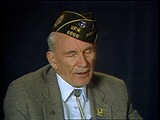You searched for: %EC%97%90%EB%B3%BC%EB%A3%A8%EC%85%98%20%EB%B0%94%EC%B9%B4%EB%9D%BC%20%EC%A1%B0%EC%9E%91%E2%97%87e49.top%E2%97%87%EC%98%A8%EB%9D%BC%EC%9D%B8%ED%99%80%EB%8D%A4%E2%97%87%ED%95%84%EB%A6%AC%ED%95%80%EC%B9%B4%EC%A7%80%EB%85%B8%20%EC%86%94%EB%A0%88%EC%96%B4%EC%B9%B4%EC%A7%80%EB%85%B8%20solaire%E2%97%87%EB%9D%BC%EC%9D%B4%EB%B8%8C%EB%B0%94%EC%B9%B4%EB%9D%BC%20%EC%A1%B0%EC%9E%91%E2%97%87oizi
<< Previous | Displaying results 451-500 of 549 for "%EC%97%90%EB%B3%BC%EB%A3%A8%EC%85%98%20%EB%B0%94%EC%B9%B4%EB%9D%BC%20%EC%A1%B0%EC%9E%91%E2%97%87e49.top%E2%97%87%EC%98%A8%EB%9D%BC%EC%9D%B8%ED%99%80%EB%8D%A4%E2%97%87%ED%95%84%EB%A6%AC%ED%95%80%EC%B9%B4%EC%A7%80%EB%85%B8%20%EC%86%94%EB%A0%88%EC%96%B4%EC%B9%B4%EC%A7%80%EB%85%B8%20solaire%E2%97%87%EB%9D%BC%EC%9D%B4%EB%B8%8C%EB%B0%94%EC%B9%B4%EB%9D%BC%20%EC%A1%B0%EC%9E%91%E2%97%87oizi" | Next >>
-
Warsaw ghetto uprising, 1943
MapThe city of Warsaw is the capital of Poland. Before World War II, Warsaw was the center of Jewish life and culture in Poland. Warsaw's prewar Jewish population of more than 350,000 constituted about 30 percent of the city's total population. The Warsaw Jewish community was the largest in both Poland and Europe, and was the second largest in the world, behind that of New York City. The Germans occupied Warsaw on September 29, 1939. In October 1940, the Germans ordered the establishment of a ghetto in…

-
Western Desert Campaign: Egypt and Libya
ArticleLearn more about the Western Desert campaign during World War II in Egypt and Libya between 1940-1943.
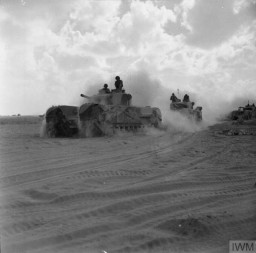
-
Ghettos in Occupied Poland
ArticleDuring World War II, the Nazis established ghettos, which were areas of a city where Jews were forced to live. Learn more about ghettos in occupied Poland.

-
Life After the Holocaust: Aron and Lisa Derman
ArticleAfter WWII and the fall of the Nazi regime, Holocaust survivors faced the daunting task of rebuilding their lives. Listen to Aron and Lisa Derman's story.
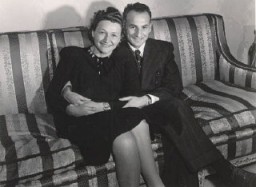
-
Forced Labor: In Depth
ArticleForced labor, often pointless, humiliating, without proper equipment, clothing, nourishment, or rest, was a core feature in the Nazi camp system from its beginnings in 1933.

-
Miriam Farcus Ingber describes witnessing a suicide attempt in the Stutthof camp
Oral HistoryMiriam was one of ten children born to a poor, religious Jewish family in Terava, Czechoslovakia. When Hungary took over the area in 1939, almost half the town's Jewish population was deported and sent to labor camps. Later, Miriam and her mother were forced into a ghetto. They were deported to the Auschwitz camp in 1944. After about three months, they were sent to the Stutthof camp. Toward the end of the war, Miriam and her mother were forced on a death march. They and others on the death march were…

-
Abraham Lewent describes hiding during a raid in which his mother and sisters were seized for deportation from Warsaw to Treblinka
Oral HistoryLike other Jews, the Lewents were confined to the Warsaw ghetto. In 1942, as Abraham hid in a crawl space, the Germans seized his mother and sisters in a raid. They perished. He was deployed for forced labor nearby, but escaped to return to his father in the ghetto. In 1943, the two were deported to Majdanek, where Abraham's father died. Abraham later was sent to Skarzysko, Buchenwald, Schlieben, Bisingen, and Dachau. US troops liberated Abraham as the Germans evacuated prisoners.
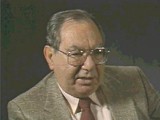
-
Frederick Dermer
ID CardFrederick was born to a Jewish family in the Austrian capital of Vienna. His father died when he was a baby, and he and his mother moved into an apartment with Frederick's widowed grandfather. As a young boy, Frederick attended a Viennese public school. 1933-39: Frederick was a rambunctious child. Once, when his grandfather was baby-sitting, Frederick used a silk lampshade as a "parachute," and jumped from the top of the wardrobe closet. That was the last time Frederick's grandfather would baby-sit.…

-
Killing Centers: An Overview
ArticleThe Nazis established killing centers in German-occupied Europe during WWII. They built these killing centers for the mass murder of human beings.

-
Beifeld album page outlining the labor service's roles in the war effort
ArtifactA page of drawings illustrating the contribution of Jewish Labor Servicemen to the war effort. At the top: "The different platoons work hard at the battle front and in the no man's land [between the armies]. They actively participate in the fighting. They carry ammunition to the Hungarian soldiers." In the middle: "They defuse land mines. They bury the dead, including those that had been left unburied from the winter campaign. They carry soldiers wounded on the front lines to safety." At the bottom: "For…
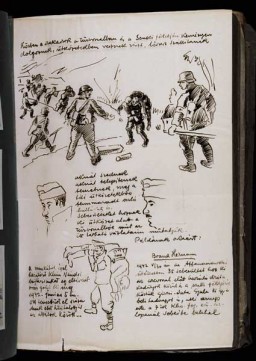
-
Sara Rachela Plagier
ArticleChildren's diaries bear witness to some of the most heartbreaking events of the Holocaust. Learn about the diary and experiences of Sara Rachela Plagier.

-
The SS
ArticleThe SS (Schutzstaffel) was the elite guard of the Nazi regime and a virtual state within the Third Reich.
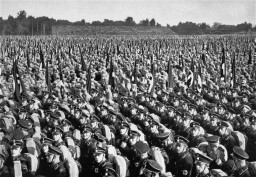
-
Eduard Schulte
ArticleEduard Schulte was a prominent German industrialist and secret anti-Nazi who leaked the first report to the west that the Nazis intended to murder all Jews in Europe.
-
Life in the Ghettos
ArticleDuring the Holocaust, Jews were forced into ghettos with terrible living conditions, overcrowding, and starvation. Learn more about life in the Lodz ghetto.

-
The Warsaw Ghetto Uprising
ArticleThe Warsaw ghetto uprising was the largest uprising by Jews during World War II. 100s of ghetto fighters fought heavily armed and well-trained Germans for nearly a month.

-
Reich Security Main Office (RSHA)
ArticleThe Reich Security Main Office (RSHA), created by Heinrich Himmler, brutally coordinated and perpetrated many aspects of the Holocaust.

-
Aron Tabrys
ID CardAron was the second of six children born to Jewish parents in Vilna, a city known as a center of Jewish cultural life. He was called Arke by his friends and family. Aron's father supported his large family on the meager income of a chimney sweep. 1933-39: As a child Aron attended a Jewish day school, and then went on to attend a public secondary school. When he was 14 his father had an accident which rendered him blind, and Aron had to start working full-time to support the family. Aron belonged to an…

-
Eva Gredinger
ID CardEva was one of three children born to Jewish parents in Vertujeni, a Bessarabian town that was 90 percent Jewish. Eva attended a public school. Her family was religious, attending synagogue every day. Eva's father made his living as a kosher butcher, preparing chicken according to Jewish dietary laws. 1933-39: In 1936, when Eva was 15 years old, her family moved to Vysoka, where she later got a job as a seamstress. Vysoka was very different from her hometown. There were only about 15 Jewish families in…

-
Janusz Piotrowski
ID CardJanusz was the eldest of four children born to Catholic parents in Plock, a town located in a rural area north of Warsaw. His father was an accountant. Janusz attended local schools, and became active in scouting. 1933-39: Janusz went to Warsaw to study civil engineering. On September 1, 1939, the Germans began bombing Warsaw. One week later, all able-bodied men who had not been mobilized were directed to retreat east. On September 17, Janusz was 90 miles from the Romanian border. That night, the Soviets…

-
Tomasz (Toivi) Blatt
ID CardTomasz was born to a Jewish family in Izbica, a Polish town whose largely religious Jewish community comprised more than 90 percent of the population. Tomasz's father owned a liquor store. 1933-39: In September 1939, a drum sounded in the marketplace, calling the town to assemble for a news report. Germany had invaded Poland. More news arrived shortly; the Soviet Union was invading from the east. Tomasz and his family didn't know what to do. Some people said to run to the Soviet side; many, including his…

-
William Denson describes postwar trials of concentration camp personnel
Oral HistoryWilliam Denson graduated from the US Military Academy at West Point in 1934 and attended Harvard Law School. He returned to West Point to teach law from 1942 until 1945. In January 1945, Denson accepted the position of Judge Advocate General (JAG) in Europe and was assigned to US Third Army headquarters in Germany. He took part in more than 90 trials against Germans who had committed atrocities against downed American pilots. In August 1945, Denson became chief prosecutor for the US government at the…

-
William Denson describes counsel provided to accused war criminals
Oral HistoryWilliam Denson graduated from the US Military Academy at West Point in 1934 and attended Harvard Law School. He returned to West Point to teach law from 1942 until 1945. In January 1945, Denson accepted the position of Judge Advocate General (JAG) in Europe and was assigned to US Third Army headquarters in Germany. He took part in more than 90 trials against Germans who had committed atrocities against downed American pilots. In August 1945, Denson became chief prosecutor for the US government at the…

-
William Denson describes finding witnesses for the postwar trials of concentration camp personnel
Oral HistoryWilliam Denson graduated from the US Military Academy at West Point in 1934 and attended Harvard Law School. He returned to West Point to teach law from 1942 until 1945. In January 1945, Denson accepted the position of Judge Advocate General (JAG) in Europe and was assigned to US Third Army headquarters in Germany. He took part in more than 90 trials against Germans who had committed atrocities against downed American pilots. In August 1945, Denson became chief prosecutor for the US government at the…

-
The Search for Perpetrators
ArticleThousands of Nazi criminals were never arrested. Learn more about the postwar efforts to bring Nazi perpetrators to justice.

-
Westerbork
ArticleThe Westerbork transit camp, located in the German-occupied Netherlands, served as a temporary collection point for Jews in the Netherlands before deportation.

-
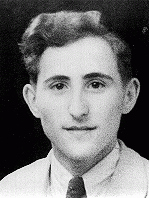
-
Concentration Camp System: In Depth
ArticleThe Nazi regime's extensive camp system included concentration camps, forced-labor camps, prisoner-of-war camps, transit camps, and killing centers.
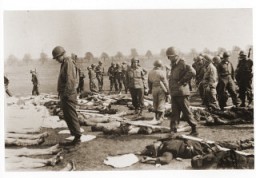
-
Felix Horn describes a hiding place in Warsaw
Oral HistoryFelix was born to an assimilated Jewish family in Lublin, Poland. His father was a locksmith and his mother was a singer. Following the German invasion of Poland on September 1, 1939, Felix fled east to Rovno and then to Soviet-occupied Lvov, where he was accepted at a medical school. After the German invasion of the Soviet Union in June 1941, Felix was taken to a labor camp. He escaped and returned to Lublin, and found that his family had been forced into the ghetto established there. After the…

-
Selma (Wijnberg) Engel describes deportation to Sobibor
Oral HistorySelma was the youngest of four children born to Jewish parents. When she was 7, Selma and her family moved to the town of Zwolle where her parents ran a small hotel. When the Germans invaded the Netherlands in 1940, they confiscated the hotel. The family had to live in a poor Jewish section of the town. Selma went into hiding but was betrayed and then sent to the Westerbork camp. In April 1943 she was deported to Sobibor, where she worked in the clothes sorting area. There, the prisoners tried to pocket…

-
How did postwar trials shape approaches to international justice?
Discussion QuestionThe aftermath of the Holocaust raised questions about the search for justice in the wake of mass atrocity and genocide. The World War II Allied powers provided a major, highly public model for establishing internati...

-
William Denson describes the nature of the evidence uncovered for postwar trials of concentration camp personnel
Oral HistoryWilliam Denson graduated from the US Military Academy at West Point in 1934 and attended Harvard Law School. He returned to West Point to teach law from 1942 until 1945. In January 1945, Denson accepted the position of Judge Advocate General (JAG) in Europe and was assigned to US Third Army headquarters in Germany. He took part in more than 90 trials against Germans who had committed atrocities against downed American pilots. In August 1945, Denson became chief prosecutor for the US government at the…

-
The Aftermath of the Holocaust
Animated MapView an animated map describing some of the challenges survivors faced in the aftermath of the Holocaust, when many feared returning to their former homes.

-
Chaim Frenkiel
ID CardChaim was the third of seven boys born to religious Jewish parents. They lived in a town near Warsaw called Gabin, where Chaim's father worked as a cap maker. Gabin had one of Poland's oldest synagogues, built of wood in 1710. Like most of Gabin's Jews, Chaim's family lived close to the synagogue. The family of nine occupied a one-room apartment on the top floor of a three-story building. 1933-39: In September 1939, two months before Chaim was 12, Germany invaded Poland. In Gabin 10 people were shot in…
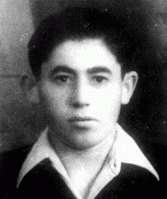
-
Jakob Frenkiel
ID CardJakob was one of seven boys in a religious Jewish family. They lived in a town 50 miles west of Warsaw called Gabin, where Jakob's father worked as a cap maker. Gabin had one of Poland's oldest synagogues, built of wood in 1710. Like most of Gabin's Jews, Jakob's family lived close to the synagogue. The family of nine occupied a one-room apartment on the top floor of a three-story building. 1933-39: On September 1, 1939, just a few months before Jakob turned 10, the Germans started a war with Poland.…

-
Andras Muhlrad
ID CardThe second of two children, Andras was born to Jewish parents living in a suburb of Budapest. His father was a pharmacist. The Muhlrads lived in a large house with Andras' grandfather and aunts. As a toddler, Andras often played with his older sister, Eva, and their cousins in the big yard behind their home. 1933-39: Andras was 4 when his family moved to their own apartment. It was 1936 when he began primary school and Hitler had already been in power in Nazi Germany for three years. At night his father…

-
David Bergman
ID CardDavid was born to religious Jewish parents in a small town in Ruthenia, Czechoslovakia's easternmost province, which had been ruled by Hungary until 1918. Located in the Carpathian Mountains, the town was so isolated that news from the rest of the country would arrive by a drummer who would read the news in the town's central square. David's father worked as a tailor and his mother was a seamstress. 1933-39: While David's parents worked, he would be at home having a good time. They had a beautiful home…
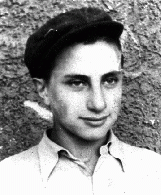
-
David J. Selznik
ID CardThe village in Lithuania where David grew up was located near the Latvian border. His father was a peddler. At age 6, David was sent to Ukmerge, a town known to Jews by its Russian name, Vilkomir, to study traditional Jewish texts at the rabbinical academy there. Six years later, David was called to return home to head the Selznik family because his father had died. 1933-39: David lost his job in 1933, so he left Lithuania and went to the United States and then Portugal. But in 1936 the Baltic states were…
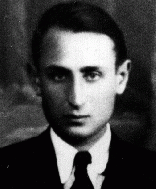
-
Dezso Rozsa
ID CardDezso was from a Jewish family in Hungary's capital, Budapest. His father had been a violinist. Dezso earned a university degree in English, and became a language teacher. He wrote a number of high school grammar textbooks. In 1914 he married Iren Hajdu, who was a mathematician. The couple had two children; a daughter, Eva, born in 1918, and a son, Pal, born seven years later. 1933-39: Dezso fears for the worst now that the antisemitic Prime Minister Teleki has taken power again. Nineteen years ago, in…
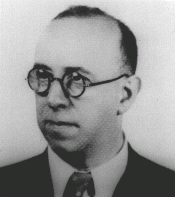
-
Arthur Karl Heinz Oertelt
ID CardHeinz, as he was usually called, was born in the German capital to religious Jewish parents. He and his older brother, Kurt, attended both religious and public schools. His father had died when he was very young. His mother, a seamstress, struggled to make ends meet. She and the boys lived in a predominantly Christian neighborhood. 1933-39: It frightened Heinz when Nazi storm troopers sang about Jewish blood dripping from their knives. But his family didn't have money to leave Berlin. In late 1939 Heinz…
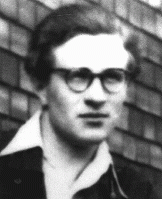
-
Aron Dereczynski
ID CardAron and his three sisters were raised in a traditional Jewish family in the town of Slonim. Most of Slonim's inhabitants were Jewish, and the town had a long tradition of Hasidic scholarship. Aron's father, Chaim, owned a yard-goods and clothing store. 1933-39: Aron attended a Hebrew-language middle school and was active in the Zionist youth movement, Ha-Shomer ha-Tsa'ir. He had been accepted to study in an agricultural school in Palestine when war broke out in September 1939 and Slonim fell under Soviet…
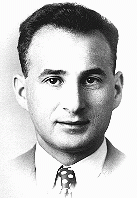
-
Nazi Racism
ArticleNazi racism and racial antisemitism ultimately led to mass murder and genocide. Learn more about Nazi racial ideology.
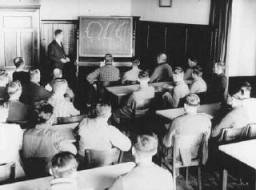
-
Herman Klein
ID CardHerman was the fourth of eight children born to a religious Jewish family in the small town of Sirma, located near the city of Sevlus. The Kleins had a small plot of land, which they farmed, and they also ran a shoe shop. At age four Herman began attending religious school. When he started public elementary school, he continued his religious lessons in the afternoons. 1933-39: In March 1939, the region of Czechoslovakia in which Herman lived was annexed to Hungary. His teacher at school was replaced by a…
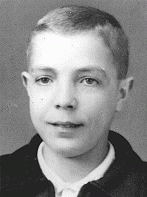
-
Magda Hellinger
ID CardMagda was the only daughter in a family of five children. Her town of Michalovce, in eastern Slovakia, was an agricultural trade center and it had a large Jewish population. Magda's father taught Jewish history in local Jewish schools. Magda grew up learning Hebrew songs and listening to stories about Jewish history. 1933-39: It's Magda's nature to work with people and to help them work together. In Michalovce she studied to become a kindergarten teacher, and worked to establish a new chapter of the…

-
Jozef Tiso
ArticleJozef Tiso was a Slovak politician and a Roman Catholic priest. From 1939 to 1945, he was the president of the Slovak Republic, one of Nazi Germany’s allies.
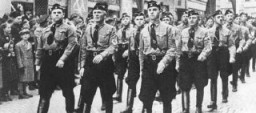
-
David Stoliar describes holding onto a piece of wreckage from the deck of the torpedoed Struma
Oral HistoryIn 1936, David moved to Bucharest to live with his father. As Romania came under German influence, Romanian authorities introduced increasingly harsh measures against Jews. Antisemitic agitation increased and Jews came under attack in the streets of Bucharest and in other public places. David's father decided David should leave the country and arranged passage for him to Palestine. In December 1941, David left Romania from Constanta, a port city on the Black Sea, on the Struma, an old cattle boat. The…

-
Helen Lebowitz Goldkind describes German humiliation of her grandfather in the Uzhgorod ghetto
Oral HistoryIn 1938-39, Hungary annexed the area of Czechoslovakia in which Helen lived. After Germany occupied Hungary in 1944, Helen and her family were deported to the Uzhgorod ghetto. As Jews, they were soon transferred to various camps, where much of the family perished. Although at times Helen was too weak to walk, she and her older sister survived Auschwitz, forced labor at a camp munitions factory, and Bergen-Belsen.
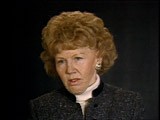
-
Fred Deutsch describes conditions in hiding place in forest
Oral HistoryFred was born in Czechoslovakia in a town near the Polish border. Fred and his family were forced by the Germans to relocate east to a town bordering Slovakia. At the end of 1942, they escaped from the town and went into hiding. The family hid in bunkers in the forest until the end of the war. They moved every few weeks to avoid detection by the Germans or Slovak authorities. While the family was in hiding, Fred's grandfather made arrangements for Fred to attend school under an assumed name and religion. A…
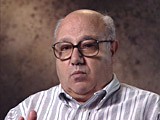
-
Sam Itzkowitz describes a death march from Landsberg, a subcamp of Dachau, to the Bavarian Alps
Oral HistoryThe Germans invaded Poland in September 1939. When Makow was occupied, Sam fled to Soviet territory. He returned to Makow for provisions, but was forced to remain in the ghetto. In 1942, he was deported to Auschwitz. As the Soviet army advanced in 1944, Sam and other prisoners were sent to camps in Germany. The inmates were put on a death march early in 1945. American forces liberated Sam after he escaped during a bombing raid.

-
Boleslaw Brodecki describes hangings in a labor camp and their impact on the prisoners
Oral HistoryBoleslaw and his older sister were raised in a Jewish section of Warsaw. The Germans attacked Warsaw in September 1939. Boleslaw's father did not want to leave his ill relatives behind, so Boleslaw and his sister escaped on a train heading for the Soviet border. The Germans invaded Soviet territories in 1941, and in 1942 Boleslaw was imprisoned in a forced-labor camp. He was deported to the Theresienstadt ghetto, where he was liberated by Soviet forces in 1945.
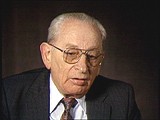
-
US veteran Raymond Buch describes forcing civilians to bury the dead
Oral HistoryAs a US Army sergeant, Raymond fought in the Battle of the Bulge. In May 1945, his unit was deployed to the Mauthausen camp in Austria to bulldoze mass graves for the victims. He watched as German civilians, on US orders, hauled bodies to the mass graves. He also saw stronger camp survivors pull clothes off their weaker counterparts to replace their own tattered uniforms. Raymond went on to Mauthausen's Ebensee camp and Gusen, guarding SS men.
